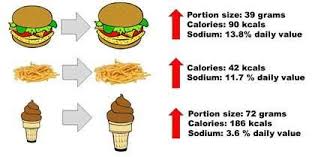- Home
- Editorial
- News
- Practice Guidelines
- Anesthesiology Guidelines
- Cancer Guidelines
- Cardiac Sciences Guidelines
- Critical Care Guidelines
- Dentistry Guidelines
- Dermatology Guidelines
- Diabetes and Endo Guidelines
- Diagnostics Guidelines
- ENT Guidelines
- Featured Practice Guidelines
- Gastroenterology Guidelines
- Geriatrics Guidelines
- Medicine Guidelines
- Nephrology Guidelines
- Neurosciences Guidelines
- Obs and Gynae Guidelines
- Ophthalmology Guidelines
- Orthopaedics Guidelines
- Paediatrics Guidelines
- Psychiatry Guidelines
- Pulmonology Guidelines
- Radiology Guidelines
- Surgery Guidelines
- Urology Guidelines
Over years fast food has greater variety, but more salt, larger portions, added calories

Past thirty-year history of fast food reveals that there is a greater variety nowadays but on the flipside, it has become more unhealthy with larger portions, more salt and more calories. In other words, fast food is even more unhealthy for you than it was 30 years ago. The study has appeared in the Journal of the Academy of Nutrition and Dietetics.
Fast-food restaurants are on the rise around the world. In the US, about 37 per cent of adults (aged >20 years) consume fast foods on any given day, and that increases to 45 per cent for adults aged 20-39. One meal with an entree and side provides an average of 767 kcals, or close to 40 per cent of a 2,000-calorie a day diet. Add a caloric beverage, and the amount increases to 45-50 per cent of a person’s daily calorie intake.
An analysis of the offerings at 10 of the most popular US fast-food restaurants in 1986, 1991, and 2016, demonstrates that fast-food entrees, sides, and desserts increased significantly in calories and sodium and entrees and desserts in portion size over time. It also shows that while the variety of entree, sides, and dessert options soared by 226 percent, new or discontinued items tended to be less healthy than those available throughout the study period.
“Our study offers some insights on how fast food may be helping to fuel the continuing problem of obesity and related chronic conditions in the United States. Despite the vast number of choices offered at fast-food restaurants, some of which are healthier than others, the calories, portion sizes, and sodium content overall have worsened (increased) over time and remain high,” said lead investigator Megan A. McCrory, PhD, Department of Health Sciences, Sargent College, Boston University, Boston, MA.
Dr. McCrory noted, “Given the popularity of fast food, our study highlights one of the changes in our food environment that is likely part of the reason for the increase in obesity and related chronic conditions over the past several decades, which are now among the main causes of death in the US.”
Dr. McCrory and colleagues examined changes over the 30-year period from 1986 to 2016 in energy, portion size, energy density, sodium, iron, and calcium of menu items in entrees, sides, and desserts categories offered by 10 of the top fast-food restaurants (according to sales). Data were collected using The Fast Food Guide, published in 1986 and 1991, and online sources in 2016. The most significant findings were:
- Total number of entrees, desserts, and sides increased by 226 percent, or 22.9 items per year.
- Calories in all three categories increased significantly, with the largest increases in desserts (62 kcals per decade), followed by entrees (30 kcals per decade). These increases were mainly due to the increase in portion size, which was statistically significant in entrees (13 grams per decade) and desserts (24 grams per decade) categories.
- Sodium also increased significantly in all menu categories.
- At four of the 10 restaurants studied, information on calcium and iron content was available. Calcium increased significantly in entrees and desserts, while iron levels increased significantly in desserts.
 From 1986 to 2016, fast-food entrees and desserts increased significantly in portion size, calories, and sodium, and sides increased significantly in calories and sodium. Credit: Megan A. McCrory, PhD, Department of Health Sciences, Boston University, February 2019.
From 1986 to 2016, fast-food entrees and desserts increased significantly in portion size, calories, and sodium, and sides increased significantly in calories and sodium. Credit: Megan A. McCrory, PhD, Department of Health Sciences, Boston University, February 2019.The change in calcium and iron levels in some of the menu categories, in particular desserts, is a positive development since these nutrients are important for good bone mass and preventing anemia. However, the investigators stress that there are better sources that do not come with high calories and sodium. Dr. McCrory expressed a hope that the study’s findings would lead to higher awareness and creative solutions. “We need to find better ways to help people consume fewer calories and sodium at fast-food restaurants. The requirement that chain restaurants display calories on their menus is a start. We would like to see more changes, such as restaurants offering smaller portions at a proportional prices,” she concluded.

Disclaimer: This site is primarily intended for healthcare professionals. Any content/information on this website does not replace the advice of medical and/or health professionals and should not be construed as medical/diagnostic advice/endorsement or prescription. Use of this site is subject to our terms of use, privacy policy, advertisement policy. © 2020 Minerva Medical Treatment Pvt Ltd